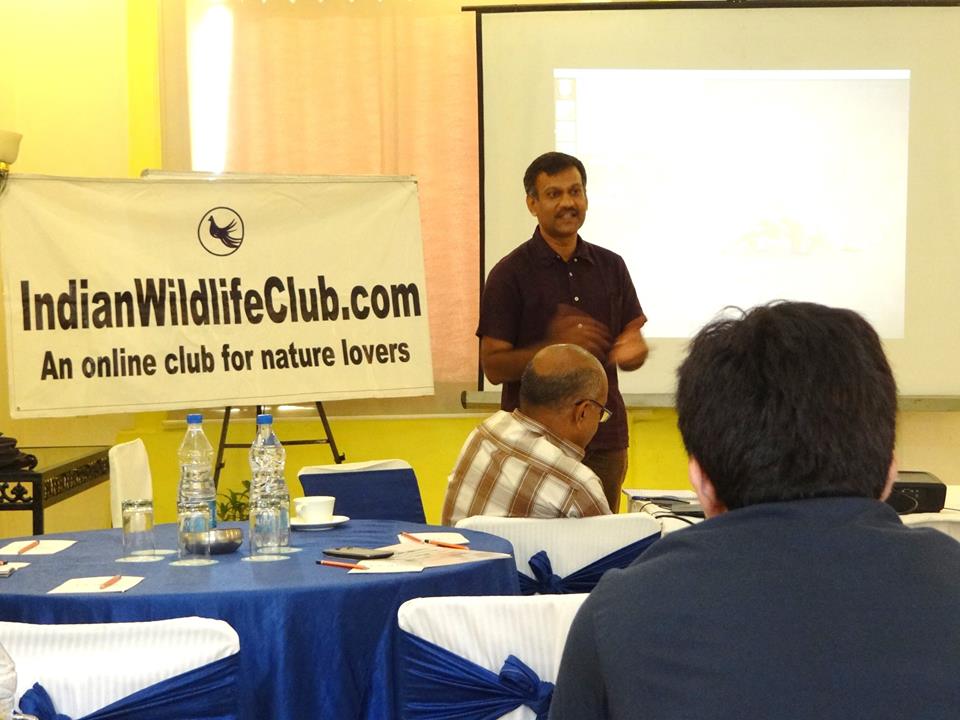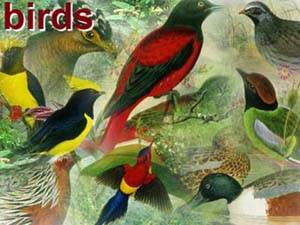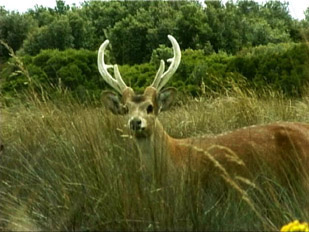Amazing Facts About Wildlife
My office in Mumbai is surrounded by deciduous forest, which is a contiguous part of Borivli National Park. I am privileged to observe variety of wildlife from the window
while working in the office. Summer is boom time especially when water scarcity brings wildlife closer to the waterhole created by us near the office. It was one of the summer evenings when I finished my day's work at about 7.30 p.m., started the scooter and
switched on the headlight. While moving the scooter, I heard a leaping movement near the water tank constructed close to the office, which is known as Conservation Education Centre (CEC) of Bombay Natural History Society. This tank being a favorite drinking
water source for wild animals during summer, I was curious to identify that moving object. When I turned the focus of scooter light towards the tank I observed a huge frog with a long, slender and moving object around it. My attempt to observe something in
the pitch dark made CEC watchmen curious and they came out with their duty torch. I parked the scooter and had a close look with the help of torchlight. I was amazed to see a bullfrog, resident of CEC tank in total control of a young cat snake (about one foot
long) . The mouth and tail of cat snake was free but the central portion was firmly gripped by the powerful jaws of bullfrog.
The cat snake's desperate attempt to escape from the jaw only helped the frog tighten its grip. The desperate and awfully irritated cat snake turned back and revengefully
attacked the frog's back. However, the "Bull" would not budge.
While observing this uncommon behavior where predator had fallen prey to its own prey and perhaps praying for life, I realized the mistake of not keeping a film role handy.
But then nature freak friends in the close vicinity are always a boon. I called up Satish Amberkar, my friend and nature photographer, who resides just 10 minutes away from CEC. Well-equipped Satish landed within 15 minutes after the call and the photo session
began, which lasted for about 10 minutes before the frog jumped in to the tank and settled in the bottom. Although water was turbid we were able to observe the drama with the torch beam. The frog was still holding the helpless cat snake in a tight grip and
the snake was determined to escape. There was a long silence. 'Snake is perhaps counting its last breath' was Satish's reaction when we observed water bubbles which surfaced from the cat snake's mouth. After some time, the snake opened its jaw and attacked
the frog with a 'do or die' spirit only to stimulate the frog's "bullish" instinct. Within a moment the bullfrog grabbed the cat snake with the help of fore limbs and gulped it. After a minute the bullfrog vanished under the leaf litter accumulated in the
tank perhaps for a good night's sleep. It was 8.45 p.m.

Prashant Mahajan
|
Lesser mammals
 Toby Ninan retired from Delhi Zoo about two years back. With Toby Ninan retired from Delhi Zoo about two years back. With
his varied experiences with the wild animals in the zoo, he is the right person to
direct your queries to. Hear what Ninan has to say about his life and chosen career!
|
Urban Delhi is a place where a number of wild animals live in the concrete jungle of the capital city ( pun unintended).
At the outset this may seem to be a strange statement- but after more than 35 years of experience in Delhi Zoo I have found this very true.
Among the commonest ones are the Rhesus monkeys which inhabit the nooks and crannies of our city buildings. A large number are found around the main offices of the Central
Government, near temples and also lately in the colonies of the city and surrounding towns.
Monkeys enjoy a hierarchical society and depend on man to provide them with food in cities.
Human beings especially those in the North of our country regularly feed these animals with fruit and other nutritious food. I have seen local folk carrying around bread,
bananas, papaya, apples and 'paranthas' dripping in pure ghee in large bags to feed hordes of monkeys at different parts of the city. The animals come and wait at these spots for a handout.In the beginning they wait and accept food if it is thrown to them;
soon they start demanding the eatables and if not offered, grab the food from willing or unwilling hands.
In the above process, the next step is realization that a mock charge will cause the people to leave their bags and flee. The monkeys then run away with the booty.
Often times seeing a group of monkeys, people, especially women and children get scared and open their eyes and mouth wide-which in monkey language means that 'I am going
to attack you'. Monkeys retaliate on impulse and leave people badly mauled with multiple bites and scratches. The lucky ones escape with torn clothes.
Monkey bites can cause rabies and hence need to be attended to immediately.
Well-fed monkeys breed rapidly and can be a menace in large thickly populated areas. The reason why these simians encroach upon human settlements is not far to see. The scrub
jungle around the city is being cut down for more and more dwelling places for city people.
The displaced monkeys who have made the Capital's North Block their home, are a sight for any visitor to the India Gate. Simians walking boldly past uniformed naval officers
and decorated Generals through the corridors of power is indeed a ludicrous sight.
 Tearing up official records is passé and no longer merits more than a passing mention in newspapers. Monkeys caught swimming in pools of cooling plants attract the ire
of security men. Tearing up official records is passé and no longer merits more than a passing mention in newspapers. Monkeys caught swimming in pools of cooling plants attract the ire
of security men.
Often we at the zoo are asked to capture these monkeys and house them at the zoo. They soon overpopulate our enclosures.
Their relocation in jungles far enough to stop their returning is also not a solution. They love to return. Who does not want a free lunch?
More about other urban wilds in my next article.
|
|
News and Views
 Five years ago, the Wildlife CD-ROM, titled "The Golden Bird" was launched. The objective was to create a product which was of the finest possible quality and aimed at the macro level of the Indian education system. The Kaleido India team has put together material
on a subject which is not very easy to document in the Indian subcontinent.where many wild species are endangered and rare to come by. The content is truly encyclopedic in its scope and designed to be of interest to a wide cross section of people from casual
browsers to experts. The content matter of the CD covers the following subject areas:
Five years ago, the Wildlife CD-ROM, titled "The Golden Bird" was launched. The objective was to create a product which was of the finest possible quality and aimed at the macro level of the Indian education system. The Kaleido India team has put together material
on a subject which is not very easy to document in the Indian subcontinent.where many wild species are endangered and rare to come by. The content is truly encyclopedic in its scope and designed to be of interest to a wide cross section of people from casual
browsers to experts. The content matter of the CD covers the following subject areas:
- Overview of Indian Wildlife -India's wild habitats
- Detailed sections on Indian animal species, comprising all groups of mammals, birds, amphibians, reptiles, and fish.
- Protected areas: Sanctuaries and National Parks.
- Conservation and Management (people and social issues, government and non- government agencies).
- Wildlife Trade and Traffic.
The CD content also constitutes a diffuse database comprising:
- Maps and overlays ( areas, species distribution and range) -Statistics, Fact sheets
- Dictionary/ Glossary of Conservation terms
- Glossary of English, Indian vernacular and Latin names. -Bibliographies and references
In addition, a high quality image bank comprising over 4000 still images( colour and B&W pictures, artworks, line drawings) and 40 minutes of edited motion film has been
incorporated in the Cd-ROM. All these have been interactively linked and users can access these as well as navigate the content of the CD through specially designed navigational screens.
In the final CD, text listings and descriptions have been integrated with pictures, video and sound and, where the subject so demands, information has been supplemented with
graphics and animations to illustrate special features.
For the expert and more technically inclined user, in depth data in the form of extract of research papers and lists of references for further reading has also been provided.
Review in "Discover India' magazine dated November 1999.
|
Story Of The Month

Grasim Industries Ltd opened a rayon pulp plant in 1963 along the river Chaliyar at Mavoor, district Kozhikode, Kerala. It produces rayon-grade pulp entirely based on bamboo
and wood for raw materials. Pulp from the Mavoor Plant fed Grasim Plants elsewhere owned by A.V Birla group.
Within months, toxic effluents including heavy metals such as mercury were discharged untreated into the river causing hundreds of fish to die. A health survey conducted
in the village of Vazhakkad, which receives much of the air pollution, revealed that 199 persons died of cancer between 1989 and 1994. Villagers are dying of cancer, asthma, cardiac arrest and chronic bronchitis around the plant, it said.
A report by CSE (Centre for science and Environment) read as under (excerpts)

"The mill claims that it has an environmental policy statement, though no document has been provided to substantiate the same. The fact that the mill is not aware of the
details of the policy raises the possibility that there is no policy or if it is there, it is for namesake. Grasim claims to have an environment department that is clubbed with the research and development wing. The department is shown to have 73 employees,
which seems to be very high. The mill’s resource consumption is marginally lower than other Indian rayon-grade pulp plants. It has revealed no documented policy on waste management or relations with local communities. Its pollution control equipment is rated
as average. The mill has a chemical recovery system and a kiln to recover lime from sludge. The company has not furnished any documented policy on adopting cleaner technology.
But areas where Grasim seems to have performed particularly poorly is water and chemical consumption. While the Indian worst average per unit water consumption stands at
200 tonnes, Grasim uses a whopping 300 tonnes of water to produce one tonne of paper. The mill is still using substantial amount of chlorine-based chemicals. It has to be noted that it is possible to bring down the figure to almost zero kg.
This makes a few things clear. The company uses a large amount of water and chemicals to produce a small amount of products. And it discharges the effluent into the river,
downstream of its uptake point. Moreover, as the Kerala Pollution Control Board (KPCB) points out, the factory does not even meet the stipulated standard for effluents. The figures indicate that the factory must be polluting the river. And that is just what
the local community complains about. They point to a rise in incidence of cancer and respiratory diseases in the region due to pollution caused by the factory.
Grasim’s fibre-use efficiency is quite low. But what is worse, the company’s water and chemical consumption is very high. Inefficiency is the other word for pollution."
Scientific studies indicated that concentrations of some toxic heavy metals were above the acceptable levels in the river beyond Chungapally, 6 km downstream of Mavoor,
where the factory discharged its effluent, clearly pointing the finger of suspicion at the factory.
Chaliyar was the lifeline of six serene paddy and coconut growing hamlets. Its people led by a cancer victim started one of the earliest known environmental agitation in
Kerala. Hunger strikes, labour strikes and lockouts plagued the plant. At least two video films were produced by activists to bring the plight of the people to the attention of the outside world. "Chaliyar-The
final Struggle" won a prize at the Mumbai International Film festival 2000. ( Click
here to read about this film). 'Unquiet flows the Chaliyar' was another video screened at the festival, again on the same theme.
On 30th June 2001, the factory was closed down and compensations paid to all its workers. The same year 'Birla White' another Birla Company became the first Indian Company
to achieve International Environmental Rating System Level 5 for excellence in Environmental Management.
Who is going to clean up the Chaliyar river? This is a question which remains unanswered.
By Susan Sharma
susan_sharma@hotmail.com
|
Tips On Beauty Without Cruelty
|

Deepika Vohra served as the head of the Department of Beauty Culture at the International Polytechnic for Women at New Delhi. She also ran a beauty clinic
at Delhi's Vasant Kunj for some time from where she relocated to New York for five years. Exposure to the world capital of beauty and cosmetics gave her an opportunity to compare the Indian beauty industry with the razzle dazzle of the New World. Reading and
researching beauty culture has always been a hobby with her. The tips for beauty given below were selected from her repertoire of nature based recipes which are time tested to deliver. |
|
'Nature Never Did Betray the heart That Loved Her.'-Wordsworth
|
|
The present times herald a veritable victory over chemical cosmetics in the form of natural beauty aids. Joy, happiness and confidence for sure contribute vastly to your beautiful appearance.
A smooth supple skin is of course an added bonus. So, here are some tips to care for your skin through the seasons.
Basic skin types may be classified into five broad categories- normal, dry, oily, combination and sensitive skin. The skin is made up of protective
layers of cells supported by nerves, glands and blood vessels. Your skin lives and breathes. Cells move up to the surface where they are shed and replaced. This topmost layer is protected by the body's natural oil and moisture. It is essential to carefully
plan out a beauty routine to attain a flawless, petal-soft complexion.
The first step to your beauty routine is cleansing your skin. Cleansers are formulated to remove surface grime and dirt as well as dissolve
stale make up from the skin. A gentle massage will help to float out deep down make up and other impurities.
How do you recognize your skin type?
NORMAL SKIN --- is finely
textured with no visible pores, spots, or blemishes, soft and velvety to the touch, and unwrinkled. Normal skin has to be treasured and preserved, as it is liable to change, if neglected.
OILY SKIN--- is caused by
overactive sebaceous glands that give rise to large open pores. Larger pores, in turn, lead to blackheads, blemishes and acne. The appearance of blackheads and blemishes is due to clogged oil and dirt in the pores which is not removed instantly by cleansing.
Oily skin begins to have an oily shine within a few minutes after wash or make-up. This makes it difficult to hold make-up. However, oily skin has an advantage of ageing very slowly, but deep cleansing must be thorough.
DRY SKIN--- is a sensitive
skin type which comes in blotches, tends to peel off easily and feels tight after a wash. Lack of moisture results in dry skin and this skin type is more prominent around the eyes, mouth, lips, sides of mouth, and forehead. Cleansing, toning, moisturizing
form an integral routine of this type of skin. Dry skin is highly susceptible to diet, extremes in weather and harsh perfumed skin care products. Dry skin also has another disadvantage. Wrinkles appear faster giving you a prematurely aged look. A generous
application of moisturizer will produce a skin which would be on par with the 'enviable' peaches and cream complexion.
COMBINATION SKIN--- As the
word 'combination' suggests it is mix of two different skin types on one face. More often this skin type is the result of a badly cleansed and neglected skin. It is easily recognizable as it is oily down the T panel, that is the forehead, nose, chin. The skin
gets this oily look down the T panel while the rest of the face appear and feel dry. Combination skin needs scrupulous cleansing. It is a good idea to use a face mask for oily skin down the T panel and a mask for dry skin for the rest of the face. This method
of treating the combination skin works ideally to give a perfect, balanced effect.
SENSITIVE SKIN---- This type
of skin is extremely delicate and vulnerable. It is easily susceptible to freckles, itchy spots and blotches. Dermatitis and allergies caused by chemical cosmetics are common problems of a sensitive skin. It is best to discontinue the usage of strong and harsh
skin care products as well as perfumed creams and moisturizers.
|
Essential oils are one of the greatest untapped resources of the world. The extra ordinary versatility of nature’s essential oils is made possible by the fact that they come
in a most convenient form. They can be applied through the skin – in massage oils or by osmosis in the bath or by inhalation in a variety of methods.Essential oils work cosmetically and as anti aging agents in several ways. Skin which has been treated with
essential oils thus become more dynamic and stronger. Essential oils can prevent the congestion of toxins and expedite the elimination of toxic debris by improving the lymphatic flow and general condition of the lymph glands. They improve circulation which
aides oxygenation and energizes the dermis (top layer of the skin) by the rate nutrients are fed to it.
CLEANSERS-
The nice thing about making your own cleansers is that you can adjust them to suit your own skin type, and change them as your skin changes with the seasons. When we cleanse our face according to its seasonal requirements we have
a skin that always looks good and ages more slowly. All vegetable and nut oils can be used for cleansing as well as for nourishing the skin. The ancient Romans massage oils into the skin and then scrape them off along with the dirt. Use any heavy oil for dry
skin such as avocado or wheat germ and light oils such as almond or sunflower for oily skins. The essential oils of Clary sage, lemon, lime, sage or thyme are cleansing and suitable for all skin types. Other good options will be rosemary, chamomile lavender
or geranium.
Here is a good oil based cleansing paste, which can be used for all skin types.
Ingredients- ·
- Almond oil -- 3 ounces ·
- Ground almonds –- 4 ounces·
- Cider vinegar –- 2 ounces·
- Spring water -- 2 ounces ·
- Essential oil of your choice –- 6 drops
Method----
Place all ingredients in a blender and mix for a good two minutes until a smooth paste is obtained. Store in a jar.
MULTI PURPOSE CLEANSING OIL INGREDIENTS- ·
- Grape seed oil --- 2 ounces ·
- Sunflower oil --- 4 teaspoons
- Sesame oil --- 4 teaspoons ·
- Wheat germ oil --- 1 teaspoon
Method— Blend these oils together and then add 5
drops of the essential oil of your choice and blend again. This can be used as a make-up remover and cleanser.
ALMOND FACE RINSE THIS IS SUITABLE FOR ALL SKIN TYPES INGREDIENTS-
- Ground almonds --- 3 ounces ·
- Corn flower --- 3 ounces ·
- Grated pure vegetable soap --- 3 ounces
Mix these ingredients in a blender and then add the following and blend again.
- Geranium --- 2 drops
- Lemon --- 2 drops
- Hyssop --- 1 drop
Store dry and use a small amount mixed with water in your hand to wash your face. Rinse well.
|
|
Extract the juice of potato and add Fuller's Earth to make a thick paste. Apply on face and rinse off. |
| |
|
Cucumber juice combined with Fuller's Earth also helps to cleanse deep down dirt and grime from your skin. |
| |
|
Mashed strawberries have excellent cleansing properties.
|
| |
|
Ripe, mashed papaya, leaves skin clean, smooth and shining.
|
| |
|
Boiled and mashed turnips combined with a little yogurt also cleanses the skin.
|
| |
|
Other natural cleansers include aloe, lemon and ginseng.
|
Deepika Vohra can be contacted at
deepika@indianwildlifeclub.com
|
Understand The Animals
 Contributed by Jyotsna Ramani (India).
Badfan_1@rediffmail.com Contributed by Jyotsna Ramani (India).
Badfan_1@rediffmail.com
The hog deer is a relatively uncommon species of deer mainly found in grasslands & riverine forests. It derives its name from it's 'hog-like' habit of crashing through the
vegetation- ducking under obstacles in the manner of a wild pig rather than leaping over them like most deer. It's scientific name is 'Cervus porcinus'. The hog deer has shoulder height ranging from 66-74 cm. It is light to dark brown in colour & develops
white spots during the summer. It is thick-set with relatively short limbs & has about 30 cm long antlers with 3 tines.
During flight it holds its tail erect, showing the white underside. They are shy animals, also known to be nocturnal & diurnal. They can be spotted singly or in small groups
but in open grasslands they may gather as a loose group. Whenever they are alarmed they give a whistle as an alarm call to others. The hog deer mainly feeds on grasses & leaves.
 Males are territorial but do not create harems. A male courts and defends a single female at a given time. Their gestation period is 8 months. one or two young are born
at a time. They are found in - North India, Nepal, Bhutan, Bangladesh & Pakistan. Due to their specialised habitat they are found in these areas and parts of South East Asia only. Recently when I was going through the web searching for info on 'hog deer' I
came across tons of hunting sites for hog deer. Can you believe that? Humans are so cruel. No wonder this species is so rare & dwindling fast. Males are territorial but do not create harems. A male courts and defends a single female at a given time. Their gestation period is 8 months. one or two young are born
at a time. They are found in - North India, Nepal, Bhutan, Bangladesh & Pakistan. Due to their specialised habitat they are found in these areas and parts of South East Asia only. Recently when I was going through the web searching for info on 'hog deer' I
came across tons of hunting sites for hog deer. Can you believe that? Humans are so cruel. No wonder this species is so rare & dwindling fast.
While as a species the hog deer is not on the IUCN's 1996 red list, axis porcinus is considered a low risk conservation dependent subspecies. In India, they can be easily
found in Corbett National Park. If you want, you can take our specialized tour to see the hog deer & many other animals like - Tiger, Indian Elephant, Red fox,Jungle cat, Wild boar, Civet, Sloth bear, Porcupine, Crocodile, Golden jackal, Leopard, Otter & several
species of deer. For further details, click on the following link :-http://www.indianwildlifeclub.com/EcoTourism/Corbett-Motel.aspx
|